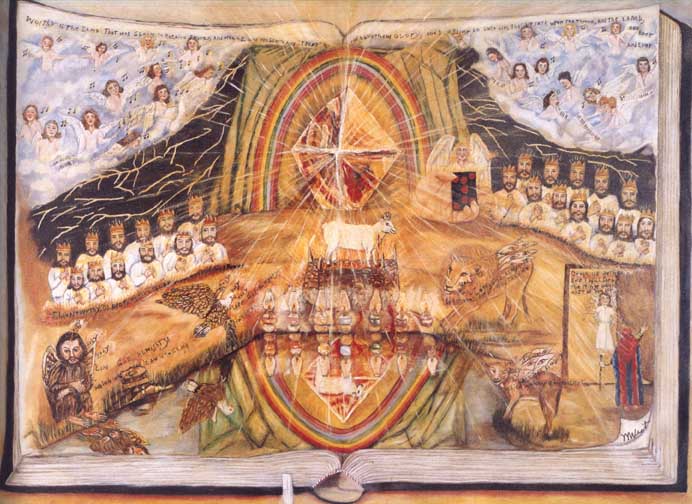

With the publication of my new book, The Origins of Heresy (Routledge 2012), I have begun new projects on comparative scripture; the Bible and the Qu'ran, and religious theme parks in the United States. I will be giving papers on these topics at the Society of Biblical Literature meeting this November 2012. I began studying Arabic in 2011 and am continuing through this year in support of my research on eschatology and the rhetoric of difference in the Qur'an.
I have worked on the artistic interpretation of the Apocalypse in the middle ages and in recent outsider art. I have presented several papers on this, focusing on the 13th century Anglo-Norman Apocalypses and the paintings of Myrtice West. Here are descriptions and some images from those presentations.
Women Enter the Picture: Queen Eleanor's Apocalypse Slide
Show
This paper will discuss the changes brought to illuminated Anglo-Norman
Apocalypses of the thirteenth century by the inclusion of contemporary women
figures. These Apocalypses (e.g. Trinity R 16 2; Oxford Douce 180; Pierpont
Morgan ms. 133; the Cloisters Apocalypse), were set in a context of increased
expectations for a new age to come engendered by the work of Joachim of Fiore,
but continue specific ecclesiological, as opposed to eschatological, interpretational
conventions. The illustrations accompany not only the biblical text but also
a gloss on that text, the Commentary of Berengaudus, Expositio super septem
visions, a twelfth century Benedictine commentary with an allegorical, spiritual
emphasis that was well suited to private devotion. Interpretational and iconographic
conventions were well-established by the 13th century. These manuscripts include,
of course, portrayals of the women characters from the Apocalypse, such as the
mulier amicta sole and the Harlot of Babylon. The Trinity Apocalypse also includes
contemporary women aristocratic figures in the illustrations to Revelation 13
and 22. Their inclusion in such pivotal eschatological moments influences both
the interpretation of the Apocalypse and the conception of "earthly"
women's roles and functions, in addition to the "heavenly" and "satanic"
women, in the eschatological age to come.
Now Write What You Have Seen: The Envisioned Visionary of the Apocalypse
Slide Show
Satan Takes Over: The Apocalypse and the Visionary Art of
Myrtice West
The language of the Apocalypse is spoken in many contexts. The most visible manifestations of the Apocalypse's influence in modern American culture are socio-political; for instance, the confrontation at Waco in 1993 or the political agenda of the "Religious Right." But the visual arts present another mode of discourse in which "Apocalyptics" is spoken. The recent publication of the work of the self-taught or "outsider" artist Myrtice West presents a striking, visual reading of the Apocalypse from within the cultural and religious traditions of rural, fundamentalist Christianity. As such, her "Revelation" series of 13 large paintings expresses typical pre-millenialist, dispensationalist interpretations of the Apocalypse. These paintings, however, are not a tract handed out in the supermarket parking lot but an entire revisioning of the most visionary text in the New Testament. This paper will focus on two paintings from the series: Painting #2, "Thou Art Worthy O Lord to Receive Glory and Honor and Power," based on Revelation 5; and Painting #8, "Satan Takes Over," an interpretation of Revelation 13. The presentation format will include digitized color slides of the artwork. After a brief discussion of the place of her iconography within the broader artistic traditions of the Apocalypse, I will examine these works in terms of two intersecting interpretive axes that have marked critical discourse on the Apocalypse; that is, the narrative and social worlds of the text. I will examine West's work in light of the scholarly dialogue of "reading the Apocalypse" in terms of how visual interpretation shades our discussions of narrative methodologies; and how the artistic texts speak to the notion of crisis in the Apocalypse, particularly social perceptions of political and cultural crisis in the modern context.
|
|
 |
|
|
 |
|
"Satan Takes Over"
|